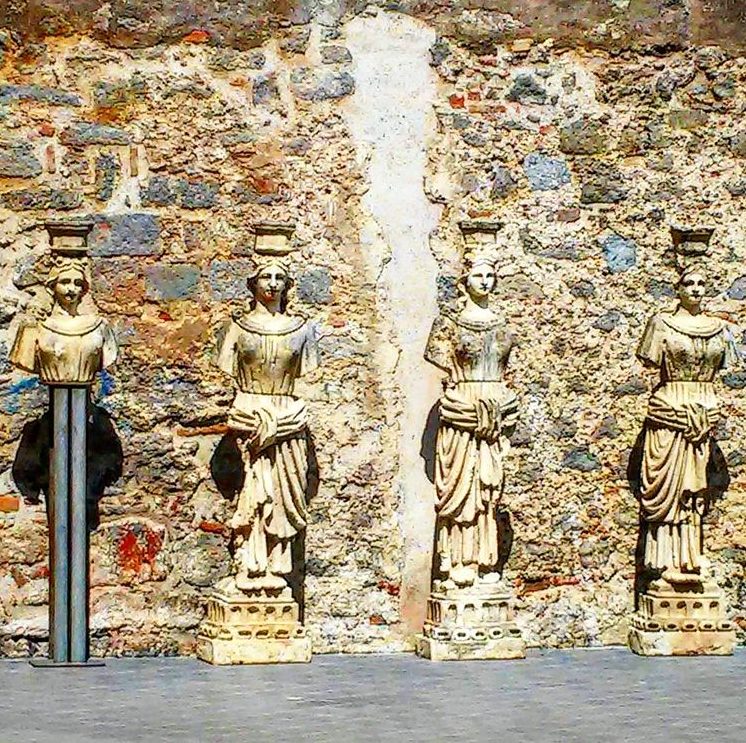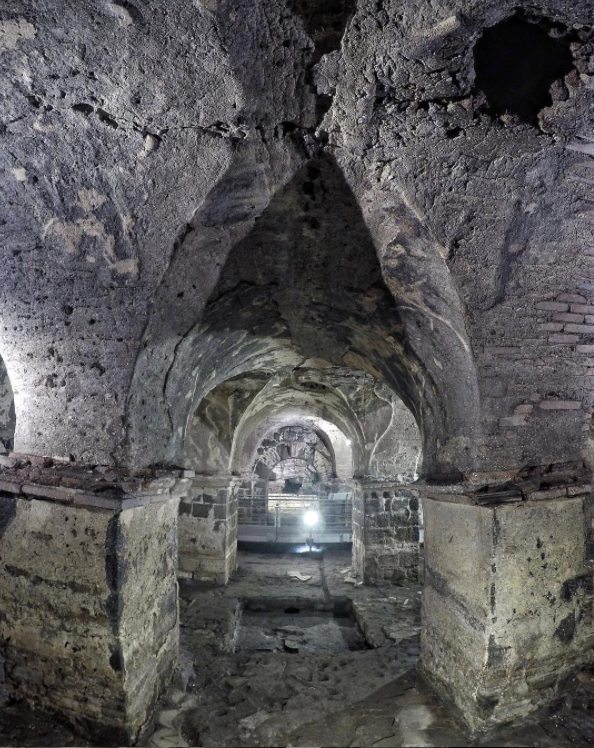Parco Archeologico Greco Romano
Just south of the Church of San Benedetto we will find the heart of the Greek-Roman Catania, the Parco Archeologico Greco Romano di Catania. The park includes the Roman Amphitheater, the Greek-Roman Theater, the Roman Odeon, the Roman Terme della Rotonda, Achellian Baths, the Roman Forum of Catania, the Roman aqueduct of Catania, the Crypt of S. Agata La Vetere, the Hellenistic necropolis in via Androne and numerous other thermal baths, necropolises, crypts and finds from that era scattered around the wider area of the park.
In front of the Benedictine Monastery are the remains of the Roman thermae complex which testify to the wealth of this area in which so many archaeological remains, mosaics, and significant tracts of ancient buildings dressed in marble and refined decoration have been found. On entering the interior of the monastery complex the visitor can see the trenches from the recent archaeological excavation that has brought to light interesting fragments of the history of ancient Catania.



The excavation is on the summit of the acropolis hill (the high part of the ancient city) where, thanks to an uninterrupted digging campaign that began in 1978, the following features have been found: significant traces of prehistoric life on the site (Neolithic and Copper Age); Greek material dating to the seventh century B.C.; fragments of built-up areas of roman Catania and the historical phases that preceded the seismic catastrophe of 1693.
According to Thucydides, Katane (Catania) was founded in 729 B.C. by the same Chalcidinians who had come from Eubea and had founded Naxos. The choice of the site was probably determined by the presence of fertile land and water. Indeed, it is not by chance that the city’s coins carried a symbol of the Amenano river (today partly visible in Piazza Duomo at the foot of the fountain of the same name), represented as a bull with a man’s face and, later, as a young man with small horns on his forehead.
Now the best way to see the Roman Theatre in V.Emanuele is to follow the route laid by the wooden paths that will lead you into the corridors of the ancient theatre.



Before going into the interior of the building observe what remains of the ancient Via Grotte, which once linked Via Vittorio Emanuele to Via Teatro Greco; it was built on strong arches made of lava stone.
The lower structures of Catania’s theatre are currently touched by the waters of the Amenano river, the same waters which according to some scholars were used for water games in ancient times. Indeed, it is the presence of this river that flows under the ancient city that is the single largest obstacle to making use of the theatre.
The ambulatories, the corridors, are reached by the vomitoria, a Latin term for the theatre’s internal entrances. On its southern side, the theatre sits on the hill where Catania’s ancient acropolis was. In the past, it could house an audience of some 7,000. The cavea, the Latin name for the semicircle holding the terraces on which the audience sat, sits on high, vaulted corridors. It is made up of 21 series of seats, divided horizontally by two aisles and vertically by nine wedges and eight stairways.


Recent archaeological excavation (1980) has brought to light: the eastern entrance to the stage building (the central entrance corresponds to the current entrance in Via Vittorio Emanuele), the wall of the pulpitum with part of the architectural decoration, still in position, and a niche on the front of the pulpitum in which a red marble statue stood, perhaps of Venus. A marble balustrade that divided the orchestra from the cavea was also discovered.
The limestone seats were originally dressed in marble while the stairways dividing the cavea into nine wedges are of lava stone. The alternation of black and white, a feature of almost all Catanese buildings, lent this sober monument an air of affectation that has been irredeemably lost today.
The terraces in the upper area have been rebuilt by restores which have demolished some of the modern houses that had invaded the theatre’s structure. The load-bearing walls of the building are made of a mixture of cement mortar mixed with stones and broken tiles; the exterior dressing is of large squared blocks of lava.



The Odeum (a small building for musical and dance performances) sits to the west of the large theatre. It is also suffocated by the high buildings that completely invade the stage area and today are used to support the painted backdrop that is set up for the summer musical program. This combination of theatre and odeum is found in other Greek and Roman cities; the main difference between the two structures is that the odeum had a roof covering. The orientation of the small construction corresponds to that of the theatre, which is in the direction of today’s Via Vittorio Emanuele.
There is however a notable difference in level in that the odeum is at the height of the highest part of the theatre-the summit of the Montevergine hill that constituted Catania’s acropolis. The semicircle of the odeum is formed by 18 walls that become progressively wider to form long and narrow wedges inside which 17 rooms were created with vaulted roofs.
The function of these rooms, restored in the 1960s, is not yet clear. The construction material for most of the building was lava stone. The orchestra (the semicircular space between the cavea[auditorium] and the stage area) is paved in marble, which is still visible. As in the theatre bricks and marble were used in contrast with the back lava which granted the building the polychrome quality that is typical of Catania’s monuments.




